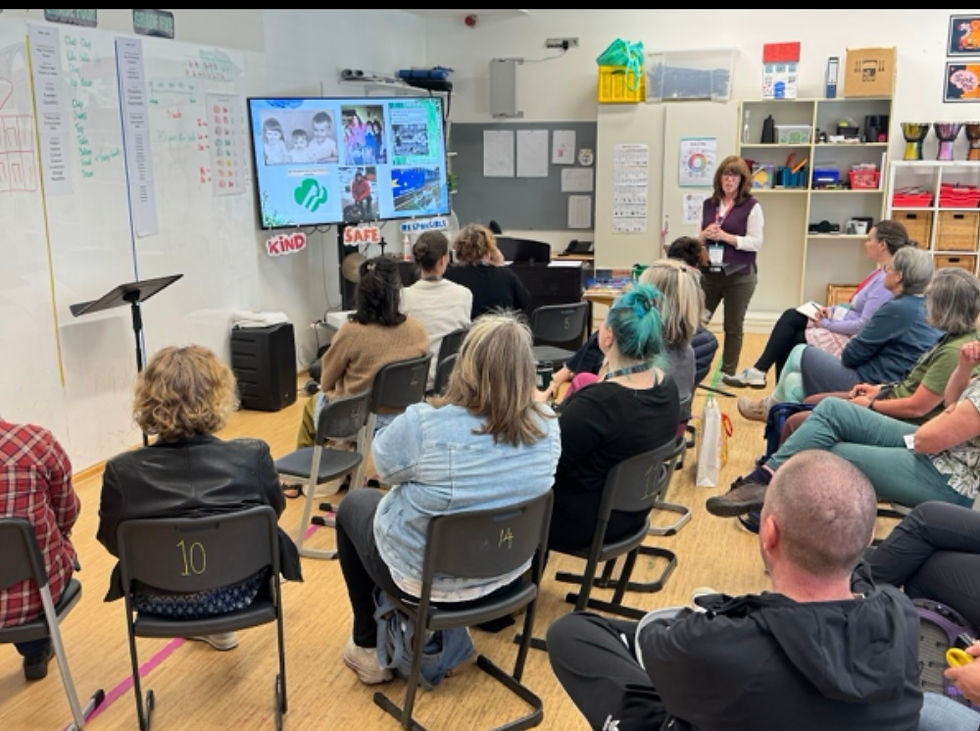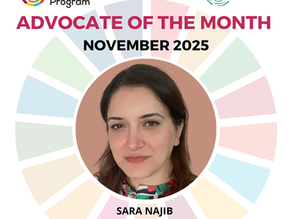Nature’s Classroom: Where Holistic Learning Comes to Life
- SDSN Youth

- Jun 30
- 4 min read
Written by Melissa Pritchard, Global School Content Lead Officer
Recently, I had the opportunity and pleasure to attend the ECIS Outdoor Learning Conference at the International School of Düsseldorf (ISD), titled Nature’s Classroom: Where Holistic Learning Comes to Life. For those passionate about Outdoor Learning (OLE)—also known as nature-based learning—ISD is a leading example of how to create meaningful outdoor experiences for young learners. This two-day conference immersed educators and leaders from around the world in ISD’s outdoor program and provided frameworks for understanding the why, how, and what of integrating OLE into the curriculum.

For advocates of Education for Sustainable Development (ESD) and Regenerative Education, outdoor learning isn’t just a pedagogy—it’s a pathway to nurturing care for the Earth. At the core of these movements is a belief that if children develop a connection with the natural world early in life, this relationship will flourish and inspire them to become lifelong environmental stewards.

To better understand this, consider the Iceberg Model, a tool from systems thinking that reveals how events are only the visible tip, while patterns, structures, and mental models lie beneath. These deep mental models shape our decisions and behaviors. When young learners are consistently immersed in nature, we help shape their values and worldview—laying the foundation for empathy, stewardship, and ultimately, sustainable and regenerative action.
Many ESD and Regenerative Education frameworks—including Design for Change and Inspire Citizens’ Empathy to Impact—are rooted in this idea of interdependence. If we want future generations to adopt sustainable habits, we must first help them care—and that care starts with direct, meaningful experiences in nature.
In a powerful interview from the Regeneration Rising podcast, regenerative systems thinker Carol Sanford argues that 90% of sustainability efforts are making things worse by focusing too much on mechanical fixes. She encourages us to develop consciousness, not just systems. This resonated deeply during the OLE conference: all systematic change in education must begin with nurturing a love relationship between children and the natural world. Especially in our increasingly digital world, this reconnection is critical. Outdoor learning in the Early Years and Primary is not enrichment—it is essential.
Learning in Action at ISD
Unlike typical conferences held in hotels or conference centers, this one took place on the vibrant ISD campus, where participants observed authentic OLE in action—with students in session. After a welcome from Head of School Frank Tschan and a choir performance, conference participants experienced a role reversal, where primary students acted as their facilitators guiding participants through their diverse outdoor learning spaces, each purposefully designed for different grade levels and types of engagement.

We observed Kindergarteners tidying their space with care, while Grade 1 students observed larva using the I See, I Think, I Wonder routine. Grade 3 learners built fires in small teams, and Grade 4 students competed in a “Measurement Olympics” using stumps and natural objects. Children confidently used tools like carving knives, fire starters, and shovels with focus and care. They were calm, engaged, and joyfully connected to their environment.





Each outdoor space reflected developmental needs and curricular goals. From wild play areas and stump circles to mud kitchens and garden beds, tamed and untamed areas, ISD’s campus is a living example of how nature can be woven into the fabric of learning. Whether rain or shine (only lightning keeps them inside!), classes move fluidly between indoor and outdoor spaces. Even pull-out instruction with EAL teachers and students happens outside.
While this impressive OLE program has evolved over 15 years, it began humbly—with a tarp strung between trees to provide a basic shelter. The transformation has been driven by all school stakeholders, including dedicated teachers and supportive administrators who made OLE a strategic priority backed by resources and vision.
Student Agency, Teacher Leadership, and Practical Tools
Students also led a series of hands-on workshops for participants—building catapults and shelters, learning how to start a fire,carving, and creating nature art—demonstrating their skills, ownership, and pride. Their facilitation reminded us that OLE isn’t just teacher-driven; it’s a space for student agency to flourish.

The remainder of the conference offered over 25 educator-led workshops. Some highlights included:
ISD’s OLE team shared their journey and practical strategies for launching and sustaining a program including budgeting, scheduling, integration, and collaboration with specialists.
Gail Kreech from the International School of Luxembourg presented research on nature-based play as a SEN intervention promoting student wellbeing and SEL.
Michelle Dolan from The Nest Preschool (Wheeler School, RI) emphasized risk assessments with students to build ownership and awareness—"as safe as necessary" vs. "too safe."
Carol Breedlove, ISD's primary school librarian and former OLE staff shared authentic ways to integrate literacy and use the library as an additional resource to foment outdoor inquiry-based learning.
Educators from less-resourced schools shared creative ways to bring learning outdoors—using nature to promote mindfulness, STEM, and spontaneous inquiry. One presenter even designs STEM challenges with a stuffed animal protagonist, showing that with creativity, every school can embrace OLE in its own way.

Regeneration as a Paradigm
As the conference closed under a sunny sky in ISD’s outdoor amphitheater, I kept returning to Carol Sanford’s paradigm: true regeneration requires a shift in worldview. Regeneration isn’t a set of actions—it’s about developing the capacity of living systems to evolve in harmony with their context. As educators, we must design learning that fosters this awareness.
My biggest takeaway? To truly nurture changemakers, we must immerse our youngest learners in nature. When children develop empathy for the natural world, they become its fiercest advocates. Breaking down classroom walls—both literal and figurative—allows students to experience the interconnectedness of life and plant the seeds for a more sustainable and regenerative future.

To echo educator and author David Sobel, “We can’t expect children to save the Earth until they love it, and they can’t love it until they’ve had meaningful, personal experiences with it.” Let us ensure those experiences are not the exception, but the norm.

















Such an inspiring conference! Integrating nature into education is key to nurturing empathy and sustainability in young learners. An AI logo maker makes it easy to craft designs that stand out. From bold metal logo creations and stylish black metal themes to energetic football graphics or refined high end branding, every detail can shine with realistic 3D effects or striking typography. Whether for your YouTube channel, a rising band, a cozy cafe, a fast food business, a sports team. competitive esports and gaming teams, or even an elegant wedding, you’ll find the perfect logo solution.
Avec les températures qui baissent le soir, je cherchais un vêtement d’intérieur qui allie chaleur et confort sans tomber dans le style négligé. Je voulais un ensemble que je pourrais enfiler dès le retour à la maison, pour me détendre sans avoir l’impression de porter une vieille tenue. J’ai donc opté pour un pyjama homme Achetez maintenant et je dois dire que j’ai été bluffé par la douceur du tissu, la qualité des finitions et la coupe impeccable. On sent qu’il est conçu pour durer, et je dors bien mieux depuis que je l’utilise tous les soirs.
Trainee teachers often struggle to balance coursework with teaching practice. PGCE university assignment help is a great support during this busy time. It makes writing easier, saves time, and helps students meet academic requirements with confidence.
I really enjoyed the Nature’s Classroom: Where Holistic Learning Comes to Life. It gave me new ways to improve how I share ideas and help others learn. I also offer Customised Audiobook Publishing Services to make educational content more engaging and easier to access.
Wow, such an inspiring approach to learning! Just like in Infinite Craft , where creativity meets exploration, outdoor education connects kids directly with nature's amazing ecosystem. These immersive experiences aren't just educational-they're transformative. By allowing children to engage authentically with their environment, we're nurturing future environmental champions who understand genuine ecological interconnectedness.